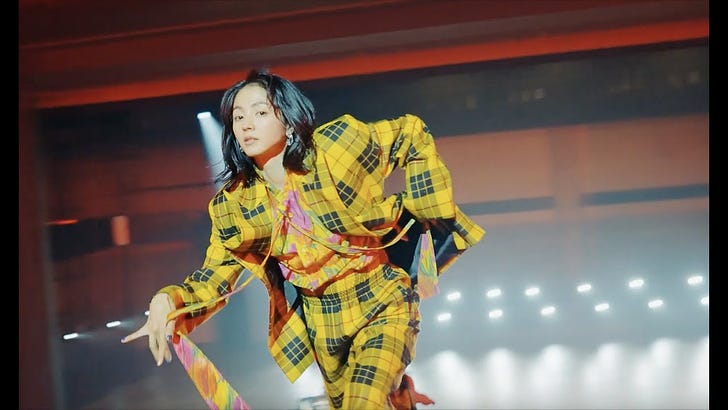Make Believe Mailer For January 24, 2022
I think I'll write about "Bad Mode" for The Japan Times, so that's why I don't focus on it here (it's great though)
Mondo Grosso Featuring Hikari Mitsushima And Ryuichi Sakamoto — “In This World”
The generational divide in J-pop…and the themes every demographic digs into…feels starker than it has ever been. You have the kids and early adults grappling with glumness, and then you have the 60-plus set reveling in good memories most won’t truly get to experience. In the middle, though, is a particular sweet spot of artists now firmly entrenched in adulthood, but still wrangling with what that means. Hikaru Utada’s Bad Mode devotes itself to exploring the little details of life in all their mundane beauty, and clinging to them (“Hope I don’t fuck it up again” moments after singing about Netflix and Uber Eats).
Mondo Grosso’s forthcoming Big World seems likely to fit into this middle-aged-and-thoughtful corner of J-pop, with “In This World” offering an ecstatic argument for giving in. Ryuichi Sakamoto provides an elegant piano melody that snakes its way around string sections and Shinichi Osawa’s club thump. Actor Hikari Mitsuhima returns to the Mondo Grosso fold after her turn on “Labyrinth,” a song where she celebrated the catharsis of surrendering to a moment. On “In This World,” she sings of surrendering to life as a whole, rejecting cynicism and screen time in favor of happiness. Those lyrics come from UA, an accomplished pop personal all her own, but here delivering the song’s crucial soul, forged by decades and sharpened into a four minute long flight. Listen above.
iri — “Matenrou”
Who needs fake nostalgia when you can live in the moment? Bucking the boom in domestic city pop which usually means laid-back tempos and easy-breezy views of life, iri plunges into the hustle and bustle of Tokyo on “Matenrou,” gliding over an urgent pace made all the more immediate by string sections and synth blurs courtesy of producer Yaffle. This head-first dive into the city has more in common with Sheena Ringo’s early wanderings through the capital than any Bubble-era act, observing and getting lost in the whirlwind. Listen above.
lil beamz — LIL BEAMZ 3.0
Part sad sack, part ready to cut loose, lil beamz offers a snapshot of where the “HyperPop community” in Japan sits as 2022 starts out. More artists are putting out EPs and albums, tip-toeing away from a SoundCloud-only existence and putting their whole sonic world on display. For lil beamz, that means fuzzy pop-punk pounders (“Speed!!”) bumping up against dancefloor euphoria (“Kawaii”) and chiptune steppers (album highlight “Stay Hydrated”). Listen above.
Hercelot — “Pre Paid Pog Punk Panic”
I don’t know what kind of video game this track corresponds with, but it must be a fucking trip if they got Hercelot to craft collage chaos nodding to the good ol’ Maltine Records days. That mellow part! Listen above.
Various Artists — brutshits compilation 2
Though let’s not pretend the netlabel concept has vanished. Sure, everything is online now, but young creators coming together under a shared digital umbrella where they can create and distribute — for free — said art. Japanese netlabel brutshits is one of the newest carrying on this tradition, and their second compilation gathers young electronic creators together to share a wide variety of brain-rattling sounds ideal for the social media age. It brings to mind another staple of this Web-centric world from a few years ago…the fogpak comp series. High-level of praise there. Get it here, or listen above.
Pachi Pachi Cosmic Computer! — “꒰ঌ処女覚♡醒革命໒꒱⡱”
Part cuddly pop, part sex-positive anthem, part…indebted to Three 6 Mafia? The groove on this thing does a fantastic job marrying the fizzy with grooves straight out of Memphis. An absolute highlight from this duo, finding something all their own. Listen above.
Beipana — Soothe Your Soul
Another entry into the burgeoning “memories of a potentially imagined Hawaii” corner of Japanese music. Beipana was one of the first on this beat, merging sounds and signals from the islands with lo-fi hip-hop and his own steel guitar playing. Soothe Your Soul helps bring on the chill vibes, but also carries ghosts of resorts past and pretend, offering a slightly off edge to these mental postcards from paradise. Get it here, or listen above.
Oricon Trail For The Week Of January 10, 2022 To January 16, 2022
Back in the day, the Oricon Music Charts were the go-to path to music stardom in Japan. Acts of all sorts traversed these lands, trying to sell as many CDs as possible in order to land a good ranking on a chart choosing to only count physical sales, even as the Internet came to be and the number of versions offered for sale got ridiculous. Today, with the country finally in on digital, these roads are more barren and only looked at by the most fanatic of supporters needing something to celebrate. Yet every week, a new song sells enough plastic to take the top spot. So let’s take a trip down…the Oricon Trail.
Aimer — “Zankyosanka / Asa Ga Kuru” (44,296 Copies Sold)
The mainstreaming of anime songs — or perhaps more like the bolding-in-Sharpie-ing of it, seeing as it has always been big, but now sits at the center of Japanese music — underlines the trickiness of relying on a single metric in assessing popularity. Aimer’s opening and closing themes to the newest season of Demon Slayer don’t require any finessing with data. It topped Oricon with a solid amount (in 2022 non-idol terms) of physical copies sold, but both have attracted millions of views online, performing well on YouTube and subscription streaming. The speedy, piano-assisted “Zankyosanka” in particular is probably the first “breakout” song of the year, and I’m not even taken into account the seemingly infinite TikTok uploads featuring it.
What complicates it, though, is Demon Slayer itself. The anime remains a phenomenon in Japan, and that means an even larger chunk of people have experienced the Aimer songs exclusively through it. That series also has international reach, which means Aimer’s music also travels further than the bulk of J-pop (see just one “reaction mash-up” above). Glancing at “44,296 copies sold” or a Spotify ranking where it’s behind Macaroni Empitsu doesn’t tell the full story, because “Zankyosanka” is all over popular culture, even if it isn’t necessarily what people are coming for.
News And Views
The album’s called Bad Mode…but it sure puts me in a “good mood!” I’ll have a review / essay on Hikaru Utada’s latest for The Japan Times this weekend, but a pair of excellent interviews with the artist appeared in English media this week. Erica Russell talked to Utada for MTV, while Bradley Stern did the same for Billboard. Both offer some great insight into Bad Mode and Utada’s current state of mind (not to mention…great to see more music journalism looking at J-pop).
I’m curious to see how Bad Mode is taken in Japan, owing to songs touching on topics the country generally frowns upon (smoking weed, taking pills, going to therapy). So far, media attention has been muted…probably because the CD version doesn’t come out until February and I imagine a lot more domestic attention will fall on it. Yet Utada’s birthday did generate some nostalgia, including a Bunshun dive into “Automatic,” including a headline-material bit about Utada “ending” Tetsuya Komuro…which is to say, Utada’s arrival marked a shift away from his sound to something new in J-pop.
Ronald Taylor interviewed SixTONES for The Japan Times, and gave a look at one of the new faces of Johnny’s & Associates…who also offer some clues into how that company (and Japanese entertainment writ large) is changing.
Superclub ageHa closes in a week, but still time to get out there and drink the pool water, which might turn you into a mutant of some sort.
“Who Is Princess? Welp, now we know the answer, as the final group from the Nippon Television and FNC Entertainment competition has formed. Meet…PRIKIL.
Not this Prickle, I’m afraid.
Looks like they will have competition from another Korean group formed from a show titled My Teenage Girl, which you might remember sounding like a nightmare.
Another festival cancels as COVID-19 numbers spike.
Fond/Sound has a nice dive into Shinji Harada, centered around his album Doing Wonders from 1986.
I knew the Tokyo episode of Netflix’s new documentary series Midnight Asia was going to be a rough watch when they started explaining what “omotenashi” was.
The series offers glances at nightlife — from music to food to drink to beyond — from across several Asian cities. Having only seen the Tokyo installment, I won’t dismiss Midnight Asia entirely (especially since Japan-centric offerings…even from generally talented authors/creators/etc…are often tripwires), but this dive into the capital really underlines a weakness of the general premise. It’s a show that wants to sum up an entire city’s nocturnal narrative through disconnected short stories, all of which could be compelling on their own (well, except the Lamborghini guy, he just seemed like a bored rich dude) but never get the attention to spread out and offer anything interesting.
If you want to dive into the story of DJ Grandma, go for it, but just give her a 30-minute docu-episode instead of trying to “say something” about modern Japan through what happens after last train.
Again, this very well could just be a Japan-episode problem, but Midnight Asia feels more like an exercise in aesthetic than actually saying anything interesting. Neon signs, bright luxury cars, underground clubs featuring extravagant costumes, craft cocktails! The constant references to “only in Japan” concepts like omotenashi, ikiru and “the nail that sticks out gets hammered” drive this home — these are surface-level ways of showcasing how different Japan is from a show only interested in the vibe of Tokyo’s nightlife. Midnight Asia talks about seemingly endless potential adventures lurking behind seemingly infinite doors, but settles for bar-hopping around just a few.
Written by Patrick St. Michel (patrickstmichel@gmail.com)
Twitter — @mbmelodies






